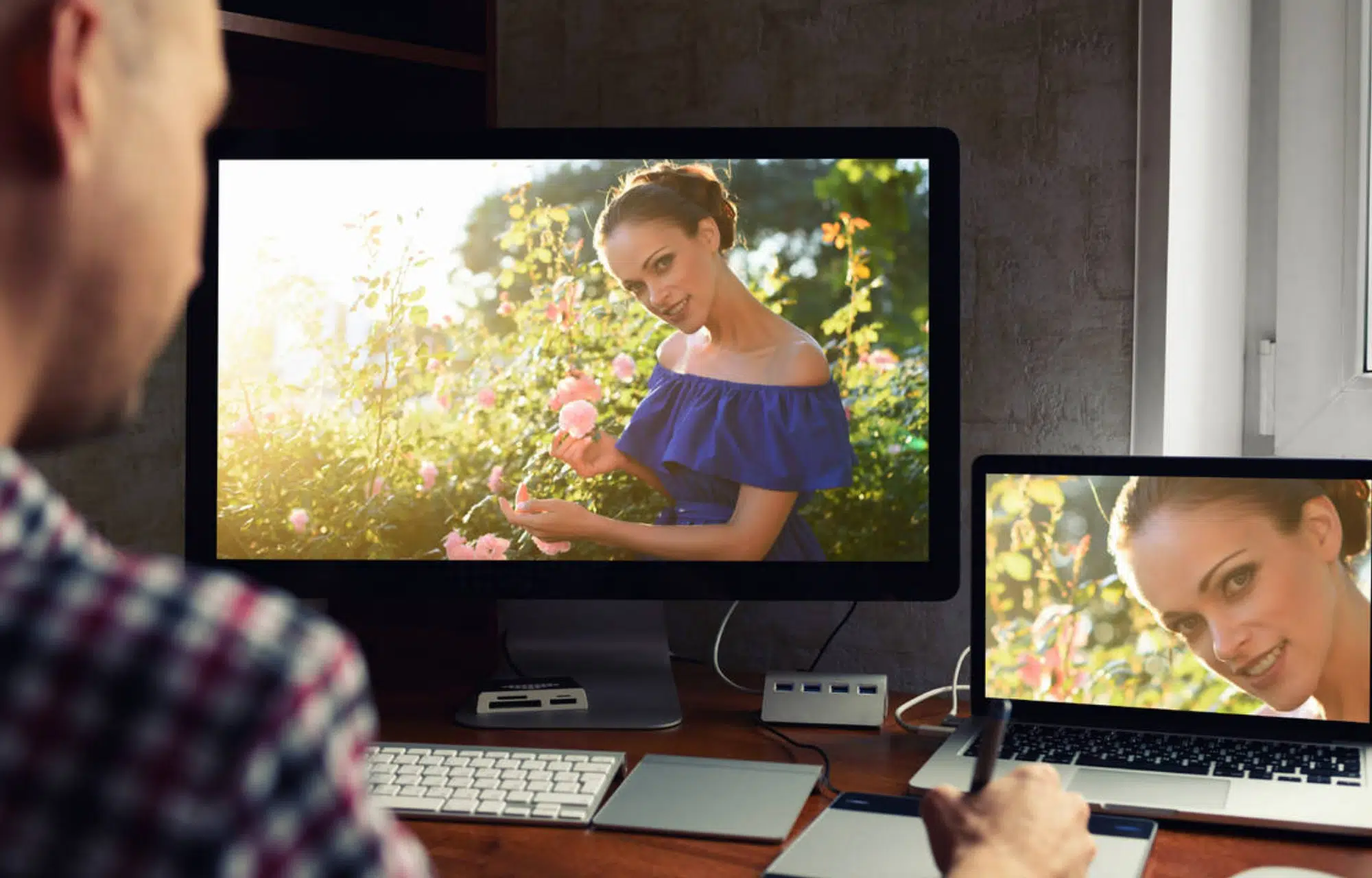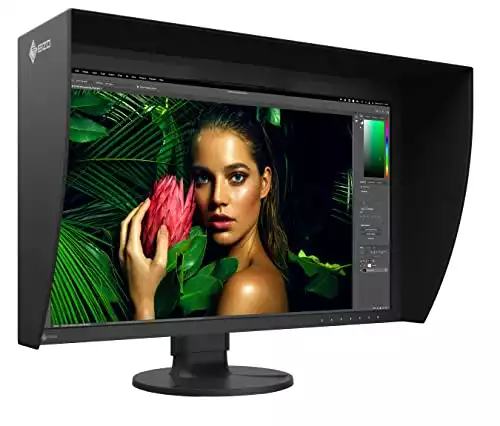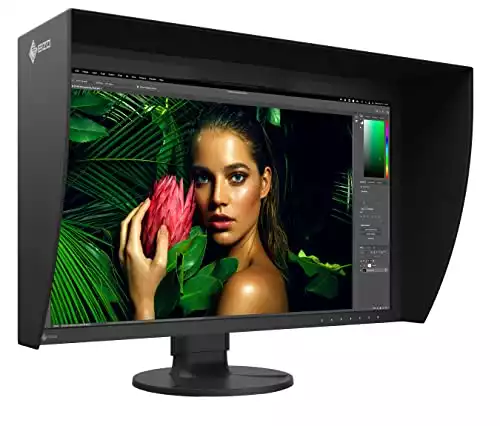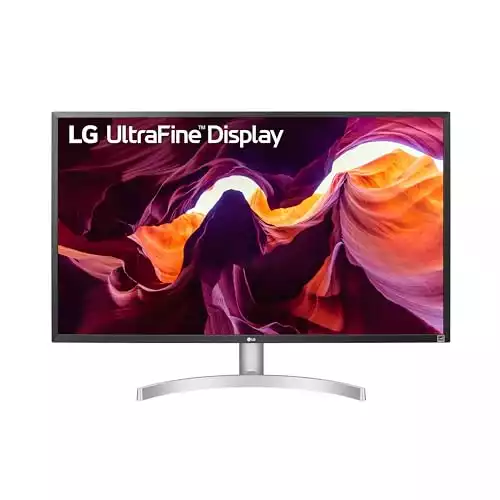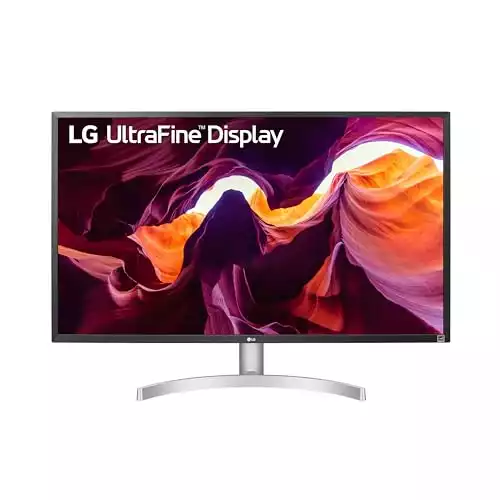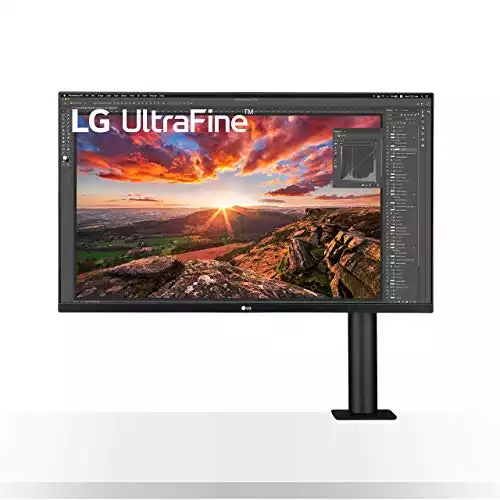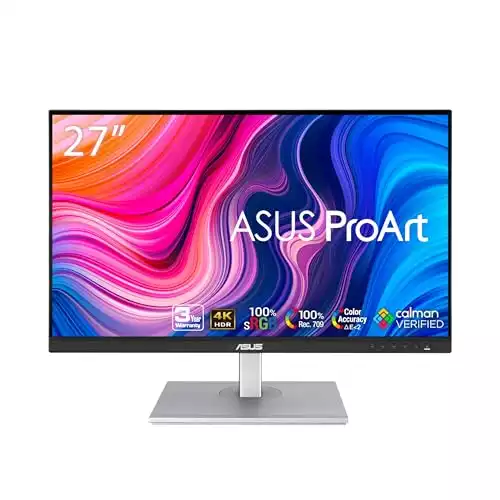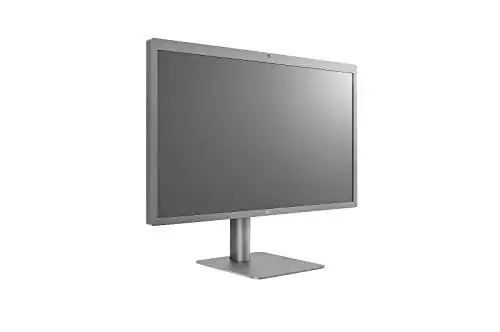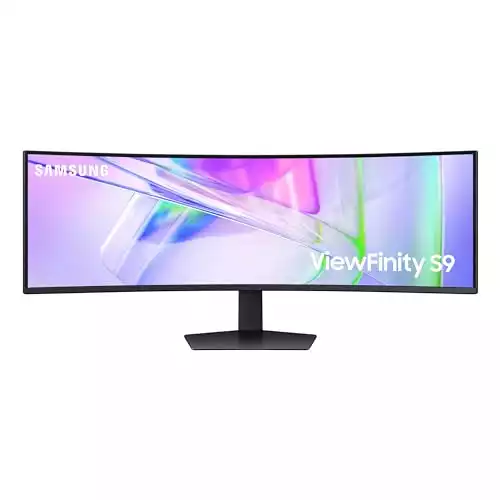Tired of editing photos that end up looking like cartoons? I’ve been there, so I took matters into my own hands and found the best monitors for photo editing. In this post, I’ll share the top picks that promise true colors and crisp details.
Get ready to upgrade your setup and enjoy precision editing that turns every photo into a masterpiece. Let’s dive in and find the perfect monitor for you!

While you’re here, why not consider trying out the best Laptops, Tablets, and AI software for photo editing to improve your shots?
10 Best Monitors for Photo Editing in 2025
Here’s a quick look at the top 11 photo editing monitors for photo editing in 2025:
- Eizo ColorEdge CG2700S (31″) — Best Overall (Editor’s Choice)
- BenQ PD3220U(32″) — Best Connectivity
- LG 27UL500-W (27″) — Best Value Option
- LG 32UN880 UltraFine Ergo (32″) — Best Second Monitor
- ASUS ProArt Display PA279CV (27″) — Best 27-inch Monitor for Photo Editing
- ViewSonic VP3881A (38″) — Best for Adobe Photoshop
- Dell UltraSharp U2723QE (27″) — Best for Office Use
- ViewSonic VP2456 (24″) — Best Budget Option
- LG 27MD5KL-B (27″) — Best 5K Monitor
- Samsung Curved Ultrawide Dual (49″) — Best for Multitasking
What is the best monitor for photo editing in 2025?
With its remarkable color accuracy, 2K WQHD resolution, and overall ability to reflect your work in vibrant and crisp visuals, Eizo ColorEdge CG2700S has proven itself to be the best photo editing monitor in the current market.
The Eizo ColorEdge CG2700S stands out for its exceptional color accuracy, 2K WQHD resolution, built-in calibration sensor, and USB Type-C port for seamless connectivity. Its large 27-inch screen offers ample space for editing, making it ideal for professionals.
- 2K WQHD Resolution
- Ample space for multitasking
- Built-in Calibration Sensor
- Thick Bezels
- Limited Ergonomics
Top 3 Best Choices
|
Primary Rating:
4.9
|
Primary Rating:
4.6
|
Primary Rating:
4.8
|
|
$2,519.00
|
$193.81
|
$246.99
|
|
Screen Size:
27 inches
|
Screen Size:
24 inches
|
Screen Size:
27 inches
|
|
Resolution size:
4K UHD
|
Resolution size:
1080p
|
Resolution size:
4K
|
|
Penal Type:
IPS
|
Penal Type:
IPS
|
Penal Type:
IPS
|
|
Pros:
|
Pros:
|
Pros:
|
- 2K WQHD Resolution
- Ample space for multitasking
- Built-in Calibration Sensor
- Flexible connectivity options
- Outstanding color accuracy
- Flicker-free technology
- High-resolution 4K UHD display
- Nearly perfect sRGB coverage
- On-screen control offers easy adjustments
Detailed Reviews of the 10 Best Monitors for Photo Editing
Check out my detailed photo editing monitor reviews to find the one that’s best suited to your photo editing needs.
1. Eizo ColorEdge CG2700S (27″) — Best Monitor for Professional Photo Editing (Editor’s Choice)

Monitor with Best Color Accuracy
Display size: 27″ | Panel type: IPS | Colour Range: AdobeRGB, Rec.709, DCI-P3 | Resolution size: 4K UHD
If you’re into professional photo editing and looking for the best monitor out there, I would always recommend the Eizo ColorEdge CG2700S.
I currently use the Eizo ColorEdge CG2700S, and its 2K WQHD (2560 x 1440) resolution is perfect for my editing work. The 27-inch screen gives me loads of space to view my projects and all the tools I need at the same time. Whether I’m editing photos and videos or working with 3D graphics, everything looks crisp and clear.
One thing I love about this monitor is its USB Type-C port. It makes connecting so much easier. I can hook up my tablet or laptop with just one cable that handles video, data transfer, and even charges my device. It’s a big help, especially when I switch between devices or work remotely.
Another huge benefit for me is the built-in calibration sensor. I used to struggle with external calibration devices, but now, my monitor automatically calibrates itself. Plus, the calibration happens in the background, so I can keep working without any interruptions.
The sharp display, combined with features like 400 nit brightness and a 60 Hz refresh rate, makes for a very satisfying viewing experience. I find myself less tired after long editing sessions, thanks to the flicker-free video and the smooth display the WLED backlight technology offers.
However, I was annoyed by the thick bezels, and the ergonomic design isn’t the best. I now use an aftermarket monitor stand to fix this issue. In conclusion, the Eizo ColorEdge CG2700S is a reliable device, packed with features that simplify workflow, and deliver exceptional image quality.
| PROS | CONS |
| ➕ 2K WQHD Resolution | ➖ Thick Bezels |
| ➕ Ample space for multitasking | ➖ Limited Ergonomics |
| ➕ USB Type-C Connectivity | |
| ➕ Built-in Calibration Sensor | |
| ➕ Low heat production | |
| ➕ High brightness (400 nits) and refresh rate (60 Hz) |
Latest Price on Amazon:
2. BenQ PD3220U (32″) — Best Connectivity

Best Ultrawide Monitor for Photo Editing
Display size: 32 | Panel type: 4K UHD | Colour Range: 100% Rec.709 & sRGB, 95% P3 | Resolution size: 4K
I usually have a lot of peripheral devices connected to my setup, which is why I sometimes prefer monitors with a good amount of connectivity options. The BenQ PD3220U Thunderbolt 3 Monitor was a great fit for me. It’s a 32-inch 4K UHD monitor that really shines when it comes to color accuracy—it covers 100% Rec.709 and sRGB and 95% P3, all with a Delta E of ≤3.
I especially appreciated features like the Pantone Validated and Calman verified technologies, which meant the colors were always spot-on. The M-Book mode was another big plus, matching Mac colors perfectly, which made my workflow smoother when I switched between devices. The ICC Sync feature was straightforward, thanks to the BenQ Display Pilot software, and I could get my color mapping done in just a second.
The ergonomic design and daisy-chain technology also made my desk a lot neater. I could connect multiple monitors without extra cables cluttering my space. The Thunderbolt 3 ports were very handy, letting me sync and charge my devices with just one cable. With two USB 3.1 ports, one USB-B port, two HDMI 2.0 ports, and a headphone jack, I had all the connections I needed.
The only downside was the built-in speakers—they just didn’t cut it for me in terms of sound quality. I usually relied on external speakers. Overall, the BenQ PD3220U is a solid choice for editing, combining great visual performance with the connectivity needed to keep all devices in line.
| PROS | CONS |
| ➕ Excellent color accuracy with 100% Rec.709, sRGB, and 95% P3 | ➖ Poor-quality built-in speakers |
| ➕ Delta E ≤3 for precise colors | |
| ➕ Pantone Validated and Calman verified | |
| ➕ M-Book mode aligns colors with Mac systems | |
| ➕ Ergonomic with daisy-chain for tidy setups | |
| ➕ Rich connectivity, including Thunderbolt 3, USB 3.1, HDMI |
Latest Price on Amazon:
3. LG 27UL500-W (27″) — Best Mid Range Monitor for Photo Editing

Best LG Monitor for Photo Editing
Display Size: 27 inches | Panel type: IPS | Color Range: sRGB | Resolution Size: 4K
LG is known for selling high-resolution monitors at affordable prices, and the LG 27UL500-W is one of the best examples I’ve come across. When I used this 27-inch 4K UHD monitor, its clarity and vibrant colors stood out immediately. It’s perfect for anyone who needs precise detail for photo editing and enjoys high-quality visuals while watching videos or gaming.
The IPS technology delivered quick response times and allowed me to see consistent colors from various angles. The color accuracy was impressive, with nearly perfect sRGB coverage. I always felt confident that the colors I was working with were true to life.
AMD FreeSync technology was a major plus when I played games on this monitor. It synced beautifully with my AMD Radeon graphics card, cutting down on-screen tearing and stuttering significantly.
I also appreciated the On-Screen Control, which let me tweak settings easily with just a few mouse presses. Adjusting brightness and switching between different game modes was a straightforward task.
However, the fact that I could only tilt the screen and not adjust its height or swivel it sometimes made it hard to get the perfect setup. I had to stack my logo design books under it a few times to get it to the right height. Also, despite the anti-glare coating, I still experienced some glare when the room was very bright, which was a bit annoying.
All things considered, the LG 27UL500-W is a fantastic monitor that combines great visuals with user-friendly features in a way that few other monitors do at this price point.
| PROS | CONS |
| ➕ High-resolution 4K UHD display | ➖ Tilt-only adjustment |
| ➕ IPS Display | ➖ Glare issues persist despite the anti-glare coating |
| ➕ AMD FreeSync compatibility | |
| ➕ On-screen control offers easy adjustments | |
| ➕ Nearly perfect sRGB coverage |
Latest Price on Amazon:
4. LG 32UN880 UltraFine Ergo (32″) — Best Second Monitor

HDR Monitor for Photo Editing
Display Size: 32 inches | Panel type: IPS | Color Range: P3 | Resolution Size: 4K
I’ve always found that a dual monitor setup significantly boosts my productivity, especially in photo editing. It allows me to extend my workspace, keeping tools and palettes on one screen while dedicating the other to a full view of the image I’m working on. From my experience, the LG 32UN880-B UltraFine Ergo monitor shines as the best option for a second monitor, enhancing editing efficiency like no other.
When I first set up this LG monitor, the 31.5-inch display with its 4K UHD resolution immediately caught my attention. The clarity and detail it brings to the table are just what I need for editing photos. The anti-glare feature on the screen also means I can work for hours without worrying about eye strain or reflection issues, which is a big plus for me.
I absolutely love the LG Ergo Stand that comes with it. The ability to adjust the monitor’s height, tilt, and swivel lets me position it just right so I can stay comfortable throughout long editing sessions.
This monitor covers 95% of the DCI-P3 color spectrum and supports HDR 10, which makes the colors in my photos pop with vibrancy and lifelike accuracy. I also appreciate how the brightness level goes up to 350 nits, making it easy to see everything clearly, even in a brightly lit room.
The connectivity options are also a standout feature for me. The USB Type-C port not only connects my devices but also charges them with 60W Power Delivery. It’s so convenient to plug in my laptop and have it charge while I work without needing an extra cable cluttering my desk. Plus, the additional USB ports are super handy for plugging in my devices and peripherals quickly.
However, it’s worth noting that the 60Hz refresh rate is not the fastest. While it’s adequate for photo editing, those looking to edit video might find it a bit limiting. Also, the built-in speakers are not the best, so I often use Bluetooth speakers when I need clear audio.
In conclusion, the LG 32UN880-B is not just about the stunning visual quality but also the ergonomic design and the practical connectivity features that make this monitor a fantastic choice for anyone looking to enhance their editing setup.
The LG 32UN880 has incredible color accuracy and an approachable price tag, making it an easy recommendation for creatives. [Jackie Thomas, techradar]
| PROS | CONS |
| ➕ Ergonomic adjustability with LG Ergo Stand | ➖ Speakers are poor |
| ➕ 95% DCI-P3 color gamut and HDR 10 | ➖ 60hz of Refresh rate |
| ➕ USB Type-C with 60W Power Delivery | |
| ➕ 3-side virtually borderless design |
Latest Price on Amazon:
5. ASUS ProArt Display PA279CV (27″) — Best Photography Monitor

Best 4k Monitor for Editing
Display Size: 27 inches| Panel type: IPS | Color Range: 100% sRGB | Resolution Size: 4K UHD
In my personal experience, a 27-inch monitor is the perfect size for photo editing, and the ASUS ProArt Display PA279CV is one of the best options I’ve come across.
The ProArt Display PA279CV boasts a 27″ 4K HDR UHD display that brings out the most vibrant and true-to-life colors. Since it covers 100% of the sRGB and Rec. 709 color gamuts, I was always confident that the colors I was editing would match those in the final product. What impressed me the most was how accurately it displays colors, thanks to its factory calibration and a Delta E < 2, which means the color deviation is minimal.
One of the best parts about using this monitor was its variety of connectivity options. It features DisplayPort over USB-C, which also delivers power alongside traditional DisplayPort, HDMI, and a USB 3.1 hub. This setup really simplified my workspace by cutting down on unnecessary cables and allowed me to connect all my devices without any fuss.
The monitor also came with a 3-month Adobe Creative Cloud Subscription when I purchased it, which was a huge bonus. It allowed me to use all the Adobe tools I needed for my projects without any extra cost for a good period.
But while this monitors is good it isn’t perfect, I noticed the default sRGB setting was a bit dim, but I was able to adjust the brightness and contrast with ease to fit my needs better. Though the design of the monitor isn’t particularly eye-catching, its performance more than makes up for it.
Overall, the ASUS ProArt Display PA279CV is a solid choice for anyone serious about photography. Its color accuracy and simple connectivity help streamline the creative process, making photo editing a smoother and more enjoyable experience.
| PROS | CONS |
| ➕ 100% sRGB | ➖ Unimpressive design |
| ➕ Respectable color space coverage | ➖ Dim sRGB setting |
| ➕ Rec. 709 color gamut | |
| ➕ Extensive connectivity options |
Latest Price on Amazon:
6. ViewSonic VP3881A (38″) — Best Monitor for Photoshop Editing

Curved Monitor for Photo Editing
Display Size: 38 inches | Panel type: IPS | Color Range: sRGB Rec 709 | Resolution Size: Wide 1440p WQHD+
When I was using Adobe Photoshop, I always preferred a bigger screen size, which is why I loved the ViewSonic VP3881A monitor. Its 38-inch curved ultrawide display opened up a much larger workspace that made it easier to see and adjust fine details in my photos.
The resolution of 3840 x 1600 pixels was a major plus. It allowed me to immerse myself in my projects, giving life to my creations in a way that smaller screens just can’t match. I was impressed with how accurately this monitor displayed colors. Since it supports 100% sRGB, EBU, SMPTE-C, Rec. 709, DCI-P3, and DICOM-SIM color spaces, I could trust that the colors on my screen were exactly what I intended them to be.
I also appreciated the ergonomic stand. Being able to adjust the monitor’s height, tilt, and swivel made it easy to find a comfortable working position, which is crucial during those long editing sessions. This really helped in reducing my fatigue and kept my focus sharp.
The connectivity options with USB-C, USB, HDMI, DisplayPort, and RJ45 Ethernet made it super simple to connect all my devices. This versatility helped streamline my workflow and kept everything running smoothly.
However, it wasn’t perfect. The HDR effect was more subtle than I expected, which might be a drawback if your work heavily relies on HDR. Also, the lower pixel density was something I noticed occasionally, as it affected the sharpness of some images, especially when viewed up close.
Despite a few minor issues, it provided a fantastic work environment for photo editing, making it a solid choice for professionals looking to boost their productivity and creativity.
| PROS | CONS |
| ➕ 38-inch curved ultrawide display | ➖ Modest HDR effect |
| ➕ Excellent color accuracy with multiple color spaces | ➖ Relatively low pixel density |
| ➕ Ergonomic stand | |
| ➕ Versatile connectivity options |
Latest Price on Amazon:
7. Dell UltraSharp U2723QE (27″) — Best for Office Use

Monitor for Photo and Video Editing
Display Size: 27 inches | Panel type: WLED | Color Range: sRGB | Resolution Size: 4K UHD
If you’re looking for a reliable photo editing monitor for office use, I’d highly recommend the Dell UltraSharp U2723QE. Having used this 27-inch 4K UHD monitor myself, I can vouch for its superb capabilities that genuinely enhance daily tasks.
First off, the visual clarity on this monitor is something else. It’s equipped with a 4K resolution that makes every detail pop, which is essential when you’re editing photos. The colors are vibrant, thanks to its 98% DCI-P3 color gamut and VESA DisplayHDR™ 400 certification, ensuring your images look true to life.
One feature I particularly appreciated was the ComfortView Plus. It’s designed to reduce blue light emissions, which was a lifesaver during those long editing sessions, helping reduce eye strain without altering the color accuracy of my projects.
The connectivity options made my life so much easier. The USB-C port not only connected to the devices but also charged my macbook with up to 90W power delivery. This was a huge plus for me as it helped reduce cable clutter on my desk. Plus, the ability to daisy chain another 4K monitor without losing quality is fantastic for when you need an even broader workspace.
The monitor is incredibly adjustable. I often changed the height, tilt, and swivel to get the most comfortable viewing angle throughout the day. It’s a small thing, but it makes a big difference in how you feel after a full day of work.
While the monitor usually handles reflections well, I did notice some issues in very bright conditions. However, in a typical office setting, it’s not much of a problem.
Overall, the Dell UltraSharp U2723QE is reliable, offers fantastic image quality, and the ergonomic features are top-notch. For anyone serious about photo editing at work, this monitor should definitely be on your list.
If you’re looking for a monitor that provides high performance, great ergonomics, and optimizes your desk space, the Dell U2723QE provides plenty of features to make it worth your consideration.[Bryce Hyland, techradar]
| PROS | CONS |
| ➕ IPS Black technology delivers deep blacks and a high contrast ratio | ➖ Reflective handling could be better |
| ➕ Built-in ComfortView | |
| ➕ Extensive connectivity | |
| ➕ Enables daisy-chaining of a second 4K monitor via USB-C | |
| ➕ Adjustable stand | |
| ➕ Quick 5 ms response time |
Latest Price on Amazon:
8. ViewSonic VP2456 (24″) — Best Budget Color Accurate Monitor
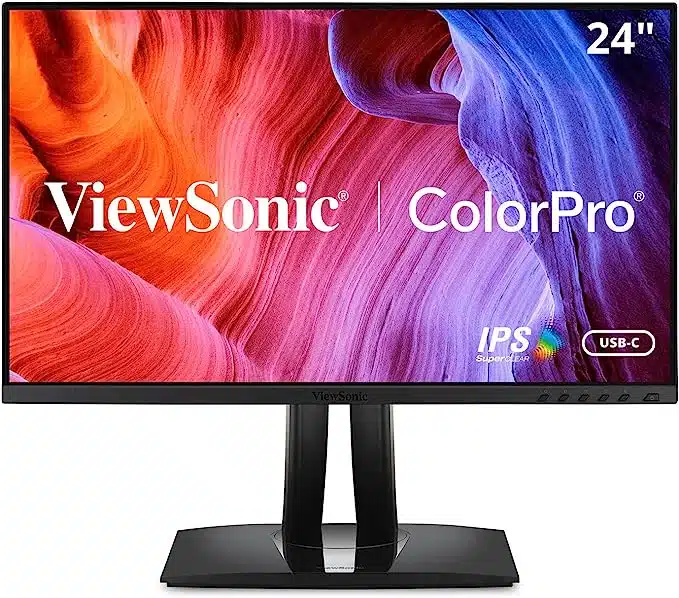
Best Ultrawide Monitor for Photo Editing
Display Size: 24 inches | Panel type: IPS | Color Range: sRGB | Resolution Size: 1080p
The ViewSonic VP2456 is the best budget option on my list of photo editing monitors. It’s particularly useful for photographers or graphic designers who need dependable color accuracy and versatile connectivity.
This monitor comes with USB-C, HDMI, USB, and DisplayPort inputs, which I found super helpful. The USB-C port also charged my laptop fast with its 60W power, which helped me keep my desk neat and tidy.
The 24-inch Full HD IPS display was a pleasure to work on. The colors were bright and accurate, making my photos look fantastic. The thin bezels also made the screen feel bigger, which I loved for editing detailed images.
I enjoyed the smooth performance too, thanks to the 60Hz refresh rate. Editing was a breeze without any annoying delays. The accurate colors were crucial for my photo edits, and with the monitor’s Pantone certification, I was confident that my photos would look exactly as I intended when printed or viewed on different devices.
However, getting used to the monitor’s button layout took some time, and I sometimes found the vDisplayManager software a bit slow, which was frustrating when I needed to make quick edits.
Overall, my experience with the ViewSonic VP2456 was really positive. Despite the few issues with the buttons and software, its excellent display and functionality made it a reliable tool for my photo editing work. It made a noticeable difference in my daily productivity and the quality of my edits.
| PROS | CONS |
| ➕ Flexible connectivity options | ➖ Confusing button layout |
| ➕ Outstanding color accuracy certified by Pantone | ➖ Sluggish vDisplayManager |
| ➕ Advanced ergonomic stand | |
| ➕ Flicker-free technology and Blue Light Filter |
Latest Price on Amazon:
9. LG 27MD5KL-B (27″) — Best 5K Monitor
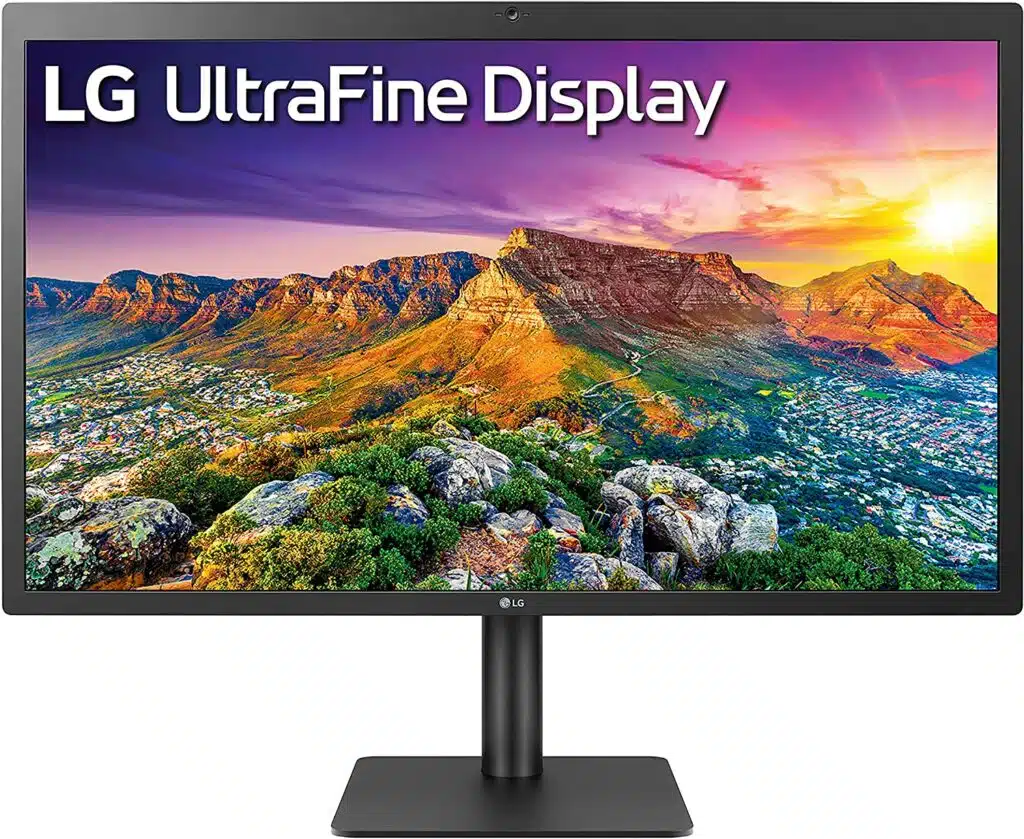
Best Monitor for Mac Mini Photo Editing
Display Size: 27 inches | Panel type: IPS | Color Range: DCI-P3 | Resolution Size: 5K
If you’re like me, someone who isn’t willing to settle for anything less than the best resolution monitor for photo editing, then you would definitely want to know about the LG 27MD5KL-B.
This monitor’s impressive 5K resolution allowed me to focus on every little detail of my work. Its 16:9 aspect ratio and wide viewing angle of 178 degrees made my designs look clear and precise from any perspective.
With its DCI-P3 99% color gamut, it displayed true-to-life hues and vibrant tones that perfectly matched my intentions. The built-in stereo speakers enhanced my editing sessions, making them more enjoyable and engaging.
I really appreciated the Thunderbolt 3 connectivity, which also supports up to 94W power delivery. It helped me keep my workspace neat by reducing cable clutter. The three USB Type-C ports were also very handy for connecting my external hard drives, cameras, and keyboards, which made transferring files and collaborating with others a breeze.
The monitor worked seamlessly with Mac OS, which was great for me since I use Apple devices. It integrated effortlessly into my setup without any compatibility issues. However, I did have some concerns about the short warranty, and I noticed the monitor could be a bit wobbly when adjusted to its full height.
Overall, my time with the LG 27MD5KL-B was incredibly productive. Though I no longer have it, the quality and performance I experienced were definitely memorable.
| PROS | CONS |
| ➕ Stunning 5K resolution with wide viewing angles | ➖ Wobbly at full height |
| ➕ In-built stereo speakers | ➖ Short warranty |
| ➕ DCI-P3 99% color gamut | |
| ➕ Thunderbolt 3 port with up to 94W power delivery | |
| ➕ Mac OS compatibility |
Latest Price on Amazon:
10. Samsung Curved Ultrawide Dual (49″) — Best for Multitasking

Best Ultrawide Monitor for Photo Editing
Display Size: 49-Inch | Panel type: Dual QHD | Resolution Size: 5120×1440
When it comes to multitasking, no screen size is ever quite enough, but the Samsung 49-inch Dual QHD Monitor really comes close to it.
I found this monitor to be an incredible asset when I needed to juggle several tasks at once. The massive 49-inch curved screen, which mimics the natural curve of the human eye with its 32:9 aspect ratio, gave me a much more immersive experience than traditional flat screens.
The built-in connectivity options were super handy. I used to plug in my laptop via the USB-C port, which also charged it while I worked, cutting down on the cables I needed and keeping my desk neat. Switching between my computer and my gaming console without having to swap cables or rearrange my setup was straightforward because of the integrated switcher that let me control two sources at the same time.
Gaming on this monitor was smooth thanks to its 120Hz refresh rate, and working on design projects was a treat with the crisp details and vibrant colors provided by the VESA DisplayHDR 400. However, I have to say the built-in speakers were just adequate—they did save space but didn’t pack the punch I prefer for music or game audio.
Let me not forget the downsides. The wide curve of the monitor meant that viewing angles could be a bit tricky, especially if I moved too far off-center. This wasn’t usually a problem for solo work sessions but could be a bit annoying during presentations or collaborative projects. The monitor’s large size also limited how much I could adjust it. Also, for such a big monitor you also need a big enough Computer Desk.
Despite these issues, the Samsung 49-inch ultrawide monitor made multitasking a breeze, and the few ergonomic challenges were a small price to pay for such a vast and versatile display.
| PROS | CONS |
| ➕ 49-inch 1000R curved display | ➖ Viewing angles can be sub-par when not sitting directly in front |
| ➕ 120Hz refresh rate | ➖ Limited ergonomics |
| ➕ VESA DisplayHDR 400 | |
| ➕ Built-in speakers | |
| ➕ Eye care technology reduces screen flickering and blue light |
Latest Price on Amazon:
How I Selected and Tested the Best Monitors for Photo Editing
To ensure that I recommend nothing but the best monitors for photo editing, I developed a comprehensive evaluation process for selecting and testing each monitor. Here’s a detailed breakdown of my selection and testing process:
Selecting Process
- Identifying Key Requirements
I started by closely examining the requirements for photo editing from my own extensive experience in digital art and design. This includes screen size, color accuracy, color gamut, resolution, brightness and contrast, lighting conditions, connectivity options, budget range, ergonomic design, response time and refresh rate, wide viewing angles, build quality, and warranty.
- Market Research
I then conducted extensive market research to identify monitor models and brands that meet the rigorous requirements for professional photo editing, graphic design, and digital art.
- Shortlisting Potential Monitors
I narrowed down the list of monitors based on the requirements I had identified and the findings from my market research. I focused on monitors known for exceptional color accuracy, high resolution, superior connectivity, and ergonomic design.
Testing Process
- Internal Testing
I created a set of criteria and tests that a monitor must pass to be recommended for photo editing. This included assessing color accuracy, resolution, brightness and contrast levels, viewing angles, and ergonomics.
- Testing Procedures
I conducted standardized photo editing tasks, graphic design projects, and digital art creation to evaluate each monitor’s performance.
- Data Collection and Analysis
After testing, I collected and analyzed data on performance metrics like color accuracy, resolution, and response time. I also noted my personal experience with each monitor regarding ease of use and comfort.
- Finalizing the Recommended Monitors
After a thorough analysis of the testing results and personal experience, I compiled a list of the best monitors for photo editing based on their performance, features, and overall user experience.
Buying Guide: How to Find the Best Monitor for Photo Editing
Have trouble deciding on the perfect monitor for your photo editing needs? Look at my comprehensive buying guide to help yourself pick the right one among the best photo editing monitors.
🎯 Color Accuracy
A monitor with accurate color reproduction allows you to make precise adjustments and achieve consistent results across different devices and print media. Monitors like the Eizo ColorEdge CG2700S and BenQ PD3220U offer a wide color gamut (such as Adobe RGB or sRGB), ensuring vibrant and true-to-life colors in your images.
🔍 High Resolution
Opt for a high-resolution monitor, like the LG 27MD5KL-B. These monitors provide sharp details and clarity, allowing you to work on intricate designs and retouching tasks with precision.
🛠️ Calibration Capability
Consider monitors that offer hardware calibration support, like the Eizo ColorEdge CG2700S. This feature enables you to achieve precise color calibration and maintain consistent color accuracy over time.
🖥️ Adjustable Stand
An ergonomic design with an adjustable stand, as seen in the LG 32UN880 UltraFine Ergo, allows you to customize the monitor’s height, tilt, and swivel to find the most comfortable viewing position. This feature is vital for long editing sessions, as it helps reduce strain on your neck, back, and eyes.
🌙 Blue Light Filter
Spending extended periods in front of a monitor can cause eye strain and fatigue. Monitors like the ViewSonic VP3881A offer blue light filters or flicker-free technology, reducing eye strain and fatigue during long editing sessions.
✨ Anti-Glare Coating
Choose a monitor with an anti-glare coating like the ASUS ProArt Display PA279CV to ensure optimal visibility and reduce reflections, providing a clearer view of your work even in brightly lit environments.
🔗 Multiple Connectivity Options
Consider the connectivity options provided by the monitor. Look for monitors like the ViewSonic VP2456 or LG 27MD5KL-B that offer multiple connectivity options such as HDMI, DisplayPort, and USB. These ports ensure seamless integration with your computer, peripherals, and other devices.
🔄 Compatibility with Photo Editing Software
Higher compatibility ensures a smooth and optimized workflow, allowing you to take full advantage of the software’s features and capabilities. So, make sure the monitor of your choice is compatible with popular photo editing software like Adobe Photoshop or Lightroom. Monitors like the Dell UltraSharp U2723QE are known for their compatibility and optimized workflow with these software tools.
👀 Wide Viewing Angles
Monitors with wide viewing angles are beneficial, especially if you collaborate with others or need to share your work with clients or colleagues. Monitors such as the LG 27UL500-W and ViewSonic VP3881A provide wide viewing angles, ensuring consistent colors and details even when viewed from different angles.
⏱️ Response Time and Refresh Rate
A low response time minimizes motion blur and ghosting, allowing for smooth and fluid visuals, while a high refresh rate ensures a more responsive and immersive experience. For digital artists, monitors with fast response times and high refresh rates, like the Samsung Curved Ultrawide Dual, offer smooth and fluid visuals, enhancing the overall experience.
🎨 Built-in Color Management Tools
Consider monitors like the Eizo ColorEdge CG2700S with built-in color management tools. These tools allow you to fine-tune color settings, calibrate colors, and create color profiles directly on the monitor.
💰 Budget Considerations
Setting a budget is essential in choosing the right monitor for your needs. Determine your budget range and consider monitors like the LG 27UL500-W or ViewSonic VP2456, which provide satisfactory performance at more affordable prices. Setting a budget is essential in choosing the right monitor for your needs.
Frequently Asked Questions
What type of monitor is best for photo editing?
The best type of monitor for photo editing is an IPS (In-Plane Switching) panel. IPS panels offer accurate color reproduction and wide viewing angles, ensuring that your photos look their best from any angle. It is ideal for professionals who require precise color representation in their work.
Is a 4K or 1080p monitor better for photo editing?
When it comes to photo editing, a 4K monitor is generally better than a 1080p monitor. The higher resolution of 4K displays provides enhanced image clarity, sharper details, and improved color accuracy, allowing you to see finer nuances in your images and make precise adjustments.
Is a curved or flat monitor better for photo editing?
A flat monitor is usually preferred over a curved one for photo editing. Flat monitors offer a more accurate representation of your images, as they don't introduce any distortions caused by the curvature of the screen. Curved monitors are more suitable for an immersive viewing experience.
Is a 32-inch monitor too big for photo editing?
Whether a 32-inch monitor is too big for photo editing depends on personal preference and your workspace. While a larger monitor can provide more screen real estate for multitasking and viewing images in detail, ensure you have enough desk space and sit at an appropriate distance to avoid strain.
Do I need a special monitor for photo editing?
While a special monitor designed for photo editing is not mandatory, it can greatly enhance your editing experience. Specialized monitors, as mentioned in my list, often offer features like a wider color gamut, hardware calibration, and better color accuracy, allowing you to achieve more precise and consistent results.
What is the best resolution for high-quality photos?
The best resolution for high-quality photos depends on your specific needs. A monitor with a resolution of 2560×1440 pixels (QHD) or higher is recommended for most professional photo editing. This ensures you can view your images with ample detail and make accurate edits without compromising quality.
Best Monitors for Photo Editing Summary
By considering factors like resolution, color accuracy, connectivity options, and ergonomic design, you can select the ideal monitor for your photo editing needs, ensuring optimal productivity and a comfortable workspace.
However, if you are unsure which monitor to go for, you can bet your bucks on the Eizo ColorEdge CG2700S. During my tests, I found this monitor to stand out in terms of image quality and performance, making it an ideal choice for professionals who are serious about crafting.
